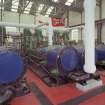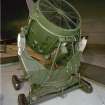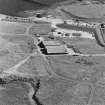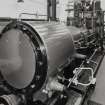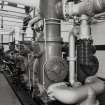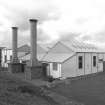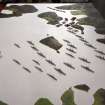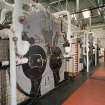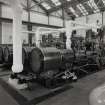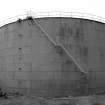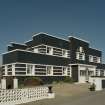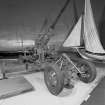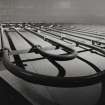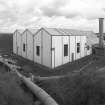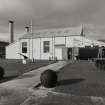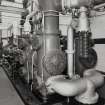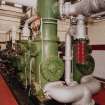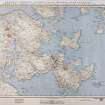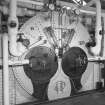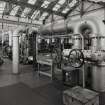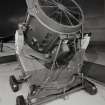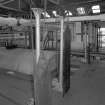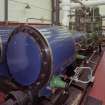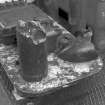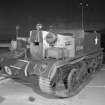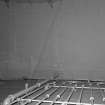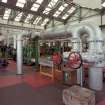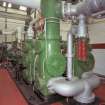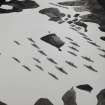Hoy, Lyness, Royal Naval Oil Terminal, Scapa Flow Museum
Boiler (20th Century), Building (20th Century), Museum (20th Century)
Site Name Hoy, Lyness, Royal Naval Oil Terminal, Scapa Flow Museum
Classification Boiler (20th Century), Building (20th Century), Museum (20th Century)
Alternative Name(s) Boiler And Pump House; Scapa Flow
Canmore ID 9487
Site Number ND39SW 20.01
NGR ND 30996 94652
Datum OSGB36 - NGR
Permalink http://canmore.org.uk/site/9487
- Council Orkney Islands
- Parish Walls And Flotta
- Former Region Orkney Islands Area
- Former District Orkney
- Former County Orkney
ND39SW 20.01 30996 94652
Formerly ND39SW 19.00
The former pumphouse, now in use as the Museum, is situated about 193m W of the W end of the present ferry terminal pier. The building has been refurbished with a new roof and is now painted white.
Internally most of the pumping and boiler equipment is still in situ and on display.
Visited by RCAHMS (DE, GS, SW), August 1997
ND 310 947 A watching brief in January 2005 during the excavation of a new pipe access trench within the Scheduled area around the oil pumping station at Lyness (ND39SW 20.01) did not record any finds or deposits of archaeological or historical interest.
Report lodged with Orkney SMR and NMRS.
Sponsor: GMJV.
J Robertson 2005
Publication Account (1996)
Lyness was the major naval base for Scapa Flow during both World Wars, and it was used by the Royal Navy until 1956. The original oil-pumping station has been renovated and used as an interpretation centre for the story of wartime Scapa Flow. The station was built in 1917 to house the steam-driven pumps that brought oil from tankers moored at the the piers into storage tanks. One of the four tanks survives, designed to hold 12,000tons of oil. The gleaming pumps were originally powered by coal, but they were converted to oil in 1936, when another twelve storage tanks were built. The displays include artefacts recovered from HMS Hampshire and from ships of the scuttled German fleet.
By 1940 there were more than twelve thousand military and civilian personnel at Lyness, and one of the great red sheds built around 1918 was converted into the largest cinema in Europe. Even more striking is the cinema built around 1942 south of Lyness (NO 307922). A huge Nissen hut was transformed by a facade built in art deco style, with its brickwork painted black and bands of white linking the windows (see p.35). The Nissen hut has been demolished and the facade is now a guesthouse.
On the hillside above Lyness are the naval cemetery and a good example of a pillbox, a small defensive look-out post so-called from its squat circular shape.
Information from ‘Exploring Scotland’s Heritage: Orkney’, (1996).
Field Visit (August 1997)
The former pumphouse, now in use as the Museum, is situated about 193m W of the W end of the present ferry terminal pier. The building has been refurbished with a new roof and is now painted white.
Internally most of the pumping and boiler equipment is still in situ and on display.
Field Visit (August 1997)
Lyness served as the centre for naval operations throughout WWI & II. The sheltered harbour offered an ideal location for refuelling and maintaining the fleet. The extensive remains of a wide range of structures associated with the base include:
(i) A boiler, a building, oil tanks, a military camp and a pillbox (ND 39 SW 20.01 -20.05).
(ii) Lyness steam pumping station and oil tank: Scheduled (HS Index 5438, 07ND 309 947- 07ND 310 947). The steam pumps were used to drive fuel oil into storage tanks. Originally coal-powered, they were converted to oil-firing in 1936. They now form a display within the Lyness Interpretation Centre. The oil tank, built in 1917, has a capacity of 12,000 tons and is the last survivor of four such tanks originally housed here.
(iii) A hand crane and pier (ND39SW 17)
Moore and Wilson, 1997
Coastal Zone Assessment Survey
Watching Brief (January 2005)
ND 310 947 A watching brief in January 2005 during the excavation of a new pipe access trench within the Scheduled area around the oil pumping station at Lyness (ND39SW 20.01) did not record any finds or deposits of archaeological or historical interest.
Report lodged with Orkney SMR and NMRS.
Sponsor: GMJV.
Condition Survey (February 2012)
A condition and structural survey was carried out on the steam crane at the Scapa FlowVisitor Centre, Lyness, Hoy, during February 2012. The brief was to assess the requirements of making the object safe by addressing structural issues, asbestos presence and stabilising / consolidating its condition for future deep conservation.
Carried out by Industrial Heritage Consulting Ltd.
Client Orkney Islands Council.
Watching Brief (1 October 2019)
ND 30982 94665 A programme of archaeological monitoring was undertaken prior to the construction of an extension to the Scapa Flow Visitor Centre, Lyness, Hoy, located upon the site of the former HMS Proserpine fleet base. This provided the opportunity to record the remains of a cooling tower which was to be partly removed during groundworks, enabling information to be gained about its character and construction. The programme also aimed to assess if any further archaeological remains were present on site. It was observed the area around the tower has been filled in and landscaped, probably in the 1980s and no further remains of archaeological significance relating to the fleet base or any other period were identified.
It is recommended that no further work on Site is necessary as part of the current scheme. However if for any reason, it becomes necessary to remove any further remains not thus far recorded (as detailed in this report), additional archaeological monitoring or intervention may be required.
The final decision as to the requirement for further work on the site rests with the Orkney Islands Council designated Planning Archaeologist.
Information from Orkney Research Centre for Archaeology (ORCA).













































